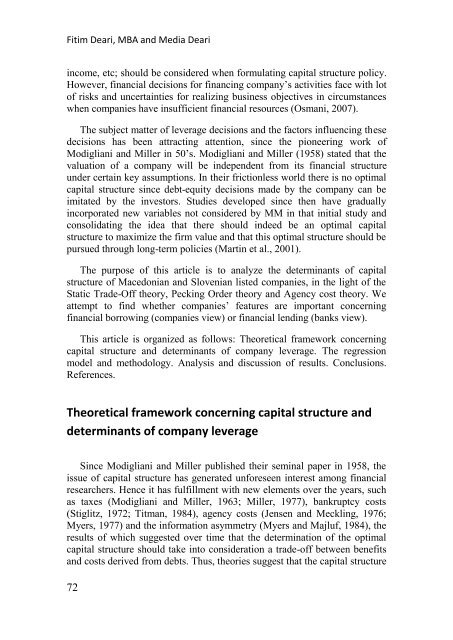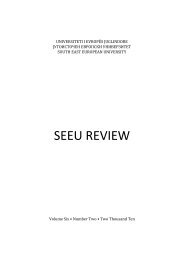SEEU Review vol. 5 Nr. 2 (pdf) - South East European University
SEEU Review vol. 5 Nr. 2 (pdf) - South East European University
SEEU Review vol. 5 Nr. 2 (pdf) - South East European University
You also want an ePaper? Increase the reach of your titles
YUMPU automatically turns print PDFs into web optimized ePapers that Google loves.
Fitim Deari, MBA and Media Deari<br />
income, etc; should be considered when formulating capital structure policy.<br />
However, financial decisions for financing company’s activities face with lot<br />
of risks and uncertainties for realizing business objectives in circumstances<br />
when companies have insufficient financial resources (Osmani, 2007).<br />
The subject matter of leverage decisions and the factors influencing these<br />
decisions has been attracting attention, since the pioneering work of<br />
Modigliani and Miller in 50’s. Modigliani and Miller (1958) stated that the<br />
valuation of a company will be independent from its financial structure<br />
under certain key assumptions. In their frictionless world there is no optimal<br />
capital structure since debt-equity decisions made by the company can be<br />
imitated by the investors. Studies developed since then have gradually<br />
incorporated new variables not considered by MM in that initial study and<br />
consolidating the idea that there should indeed be an optimal capital<br />
structure to maximize the firm value and that this optimal structure should be<br />
pursued through long-term policies (Martin et al., 2001).<br />
The purpose of this article is to analyze the determinants of capital<br />
structure of Macedonian and Slovenian listed companies, in the light of the<br />
Static Trade-Off theory, Pecking Order theory and Agency cost theory. We<br />
attempt to find whether companies’ features are important concerning<br />
financial borrowing (companies view) or financial lending (banks view).<br />
This article is organized as follows: Theoretical framework concerning<br />
capital structure and determinants of company leverage. The regression<br />
model and methodology. Analysis and discussion of results. Conclusions.<br />
References.<br />
Theoretical framework concerning capital structure and<br />
determinants of company leverage<br />
Since Modigliani and Miller published their seminal paper in 1958, the<br />
issue of capital structure has generated unforeseen interest among financial<br />
researchers. Hence it has fulfillment with new elements over the years, such<br />
as taxes (Modigliani and Miller, 1963; Miller, 1977), bankruptcy costs<br />
(Stiglitz, 1972; Titman, 1984), agency costs (Jensen and Meckling, 1976;<br />
Myers, 1977) and the information asymmetry (Myers and Majluf, 1984), the<br />
results of which suggested over time that the determination of the optimal<br />
capital structure should take into consideration a trade-off between benefits<br />
and costs derived from debts. Thus, theories suggest that the capital structure<br />
72

















